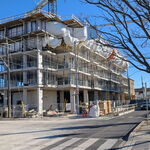WB62
Senior Member
I found concept schedules for 2032 5pm outbound Lakeshore West departures from Union Station in a Union Station Enhancement Project document that was on a City of Toronto website.
The schedules I found was from a 2021 draft that was likely presented to Metrolinx by OnXpress during the bidding process for GO Expansion.
On the left is the schedule that was included in the 2018 GO Expansion FBC for comparison. We won’t know how much this concept has changed until we get more information about GO Expansion once the development phase is over, but for now this is a good idea of how the scope of the project has increased since the 2018 case:

To clear up possible confusion, the column on the right says “2023 concept” because the USEP document was published in 2023, but it included a 2021 concept schedule, I didn’t realise the schedule was 2 years older than the document until I had finished this diagram.
The schedules I found was from a 2021 draft that was likely presented to Metrolinx by OnXpress during the bidding process for GO Expansion.
On the left is the schedule that was included in the 2018 GO Expansion FBC for comparison. We won’t know how much this concept has changed until we get more information about GO Expansion once the development phase is over, but for now this is a good idea of how the scope of the project has increased since the 2018 case:
To clear up possible confusion, the column on the right says “2023 concept” because the USEP document was published in 2023, but it included a 2021 concept schedule, I didn’t realise the schedule was 2 years older than the document until I had finished this diagram.
Last edited by a moderator:




